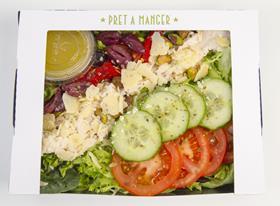
What is the snack salad market like compared to last year?
Our snack salad category has grown by 236 per cent in volume year on year between 2013 and 2014. This was driven by an increased range of choices in our salads pots – moving from one pot to three or four new flavours – which varies according to the different times of the year. Total sales for salads have grown by 22 per cent in volume over the same period.
What are the current consumer trends in snack salads?
Salad pots are becoming more popular, which you can see from the growth we have had in this category. They are convenient snacks – much easier to eat on-the-go than some of our leafy salads. Protein is also key, and the protein focus within our salad pots has no doubt contributed to its success. Our egg and spinach pot is a clear bestseller, accounting for 50 per cent of the volume within the pots category, and is used by many customers for a morning protein fix – 38 per cent of sales are during the breakfast period.
We expect to see more focus on grains-based salads in 2015, as customers look for healthy but more substantial alternatives to sandwiches.
How does the process of new recipes come about and how does this link to the supply base?
We have a team of chefs who work away in our kitchen creating new and exciting recipes. They also spend a lot of time researching interesting and healthy ingredients, which we then work with our suppliers to source in a sustainable way. All our salads and sandwiches are made fresh every day by the chefs in our shop kitchens.
What is the structure of the Pret supply base for salad and salad ingredients?
We work with key partners on salad components to make sure that we are sourcing the best-quality ingredients for
our customers.
What is the most popular Pret salad and how do you see this developing?
The Chef’s Italian Salad is a longstanding salad in the range and continues to be the most popular with our customers. Our wild crayfish and avocado is an iconic Pret product and is our second bestseller. In 2014 we launched two sushi salads, which added a new dimension to the salad category and attracted new consumers. These were a key contributor to our strong growth last year.
How do marketing and buying plans differ in winter and summer months?
Our salad volumes almost double from mid-winter to the height of summer. Weather is the key driver of this but we also extend our salad range during the summer to increase choices for our customers. Typically the range is 40 per cent bigger in the summer. For the winter, there is a stronger focus on protein and hearty ingredients as customers look for more filling salads. Buying plans will change from winter to summer – although our supply base remains the same, we work with our suppliers to source more locally where possible during the Summer months.
What will the ready-to-eat, convenience and snack salad market look like in the future?
We expect the growth in this sector to continue as consumers become more health conscious and seek more nutritionally-beneficial meal options. Customers already assume we will deliver delicious and healthy products for them; it will be key to ensure we take this a step further to keep the range exciting.



